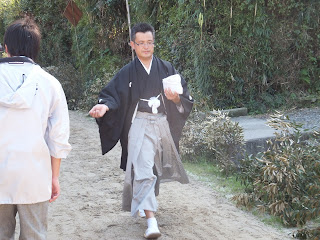KOYAMA YABUSAME Festival took place today, October 16th 2011, in the KIMOTSUKI town.
A archer shoots an arrow.
YABUSAME is a Japanese traditional horse back archery (the shooting of arrows by samurai while riding a horse). It’s a shrine ritual for the peace and security of a nation, the productiveness of grain and the secure protection from plagues.
*FYI: KOYAMA is the name of a district of KIMOTSUKI town.
YABUSAME is carried out at some shrines nationwide in Japan. Here in KIMOTSUKI town, it is carried out at SHIJYUKUSYO Shrine, which was established during HEIAN era (794-1192), in October every year.
SHIJYUKUSYO Shrine
The grand festival including YABUSAME ritual of SHIJYUKUSYO shrine used to take place on October 19th, but recently it has been taking place on the third Sunday of October in order that as many visitors as possible could come to see the festival.
According to the homepage of KIMOTSUKI town, YABUSAME originally began in 1096 and the ritual at SHIJYUKUSYO shrine began in the first half of the 1100s. This means that YABUSAME here in KIMOTSUKI town amazingly has about 900-year history.
YABUSAME has been being handed down over the generations by the “YABUSAME Preservation Society”.
A main archer is picked out of the second grade school boy of a local junior high every year. The former archer who played the main archer in the previous year is supposed to play a sub-archer.
Main Archer
In most cases, the archer has no experience to ride a horse when he is picked out. So he has to start by horse riding to play the YABUSAME archer.
The training begins at around one month ahead of the festival.
It is believed that the archer must have been struggling with a sense of responsibility for the success in the ritual and a fear of fall from the horse.
The archer is supposed to go for the ritual bathe to the KASHIWABARU seashore near the river mouth of the Kimotsuki River for purification two days ahead of the festival and to isolate himself from his family.
On the day of the festival, after blessed by the Shinto priests in a traditional ritual at the shrine, the main archer and sub-archer perform YABUSAM.
YABUSAME is performed at about 330m long riding road along the approach to the shrine.
There are three targets along the riding road.
After one test run, the archer is supposed to perform three runs to shoot three arrows each run.
The archer’s father is supposed to sprinkle the salt to purify the riding road ahead of each run.
Purification of Riding Road
Sub-archer is supposed to heel the horse in order to shoot arrows as a substitute if the main archer falls from his horse.
As the ritual, it is better that as many arrows as possible meet targets.
However, it is said that the archer does not make all nine arrows meet targets. Why? It is believe that the following year must be worse if all arrows meet their targets, like the full moon is sure to wane on the next night.
This year, six arrows of the nine met the targets.
I believe the following year would be better than this year!


















